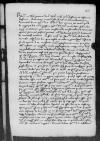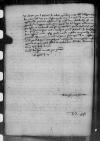Servitorem hunc Reverendissimae Dominationis Vestrae biduum hoc retinui, ut certum quid de negotiis his nostris possem Reverendissimae Dominationi Vestrae renuntiare, sed in hac rerum mutatione, cum cura constituendae rei familiaris vacantis episcopatus primas posceret partes, non potuit hactenus de maioribus tractari.
Effeci autem, ut venerabilis dominus ⌊Achatius de Trencha⌋ absolutis hic, quae restant, et ordine gerendorum constituto se ad Reverendissimam Dominationem Vestram conferat, coram expositurus omnia, quae scire illam referet, ac consilia mea explicaturus, neque enim litteris et tabellariis omnia videbantur credenda. Veniet ⌊is⌋ ⌊Lobaviam⌋ 1537-07-15⌊Dominica proxima1537-07-15⌋ vel 1537-07-16⌊sequenti secunda feria1537-07-16⌋.
Designatus est administrator ecclesiae, dominus cantor, qui in ⌊castro Heilsberg⌋ usque ad adventum successoris episcopi commorabitur. Quantum perspicere licet, deputabitur nuntius ad ⌊regiam maiestatem⌋, dominus ⌊Alexander Sculteti⌋, postulatum ea, quae sunt in pactis. Sed facit rem ambiguam, quod incertum habetur, quo loco sit ipsa ⌊regia maiestas⌋. Miseram, ut id rescirem, ad dominum ⌊castellanum Gedanensem⌋, qui putat ⌊Leopolim⌋ profectam opinaturque eum locum in regno reputari, quod si esset, ibi quoque adeunda esset ⌊eius maiestas⌋ non sine rerum et viarum multo dispendio.
Erravi nuper scribens negotium nominationum apud capitaneum Marieburgensem agendum esse, si rex extra regnum et archiepiscopus extra suam provinciam esset constitutus: diligentius exploratis pactis invenio non ⌊capitaneum illum⌋, sed vel ⌊Wladislaviensem⌋, vel ⌊Plocensem episcopum⌋ esse adeundum nuntiis capitularibus. Ac facit hoc quoque non parum nos perplexos, de ⌊Plocensi⌋ enim, cuius praesentia plus nobis usui esset, quo in loco sit, tam nobis est incertum, quam de ⌊rege⌋ ipso.
Si, quod metuo, iam abiit ad ⌊regem Romanorum⌋ legatus, non esset hoc ex re nostra. Operae pretium est, ut quam primum mihi significet Reverendissima Dominatio Vestra, si quid certi rescierit de his rebus et an sentiat ⌊regiam maiestatem⌋ prosequendam usque ⌊Leopolim⌋. Omnino non est omittendum, quin Reverendissima Dominatio Vestra, ubi de consiliis nostris certa erit, proprium nuntium mittat ad reverendissimum ⌊dominum Plocensem⌋ vel ad ⌊regem⌋ ipsum, ne nesciant statum istarum rerum et quemadmodum instituendum sit nominationum negotium. Paratum habeat Reverendissima Dominatio Vestra tabellarium, ut edocta per dominum ⌊Achatium⌋ de rebus omnibus, mox illum ableget. Nihi[l] hic intermittam eorum, quae ad firmandam rem Dominationis Vestrae Reverendissimae {Dominationis} et omnia exploranda pertinere videbuntur. In urbem ⌊Romam⌋ scribendum est, ne procedatur in negotio coadiutoriae, verum ut litterae regiae reddantur ⌊pontifici⌋ et cardinali, non est omittendum, quo de voluntate ⌊maiestatis regiae⌋ quam primum sint certi. Reliqua per dominum ⌊Achatium⌋. In ⌊Heilsberg⌋ bene cesserunt omnia estque probe curata custodia et quaecumque ad ea[m] pertinent. Breviorem me nunc cum venia feret Reverendissima Dominatio Vestra, affatim omnia per dominum ⌊Achatium⌋ recensebuntur.
Commendo me in gratiam eiusdem Reverendissimae Dominationis Vestrae, quam cupio felicem et valetudine commoda.


